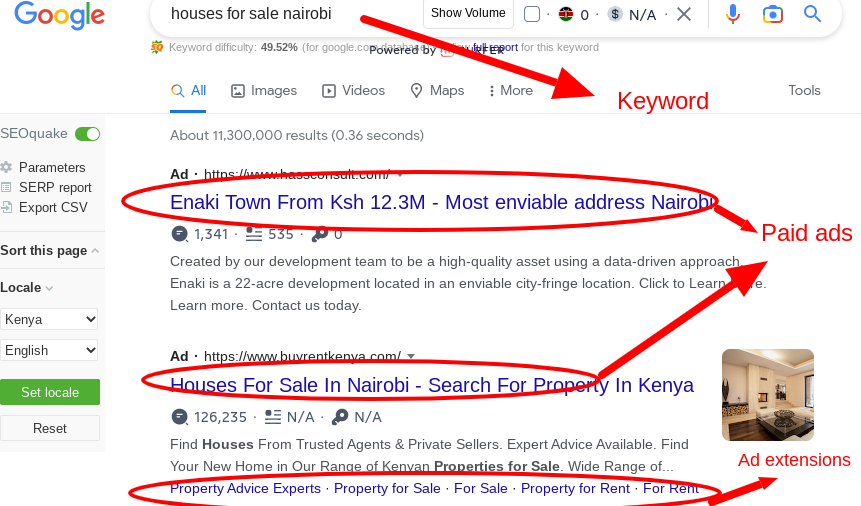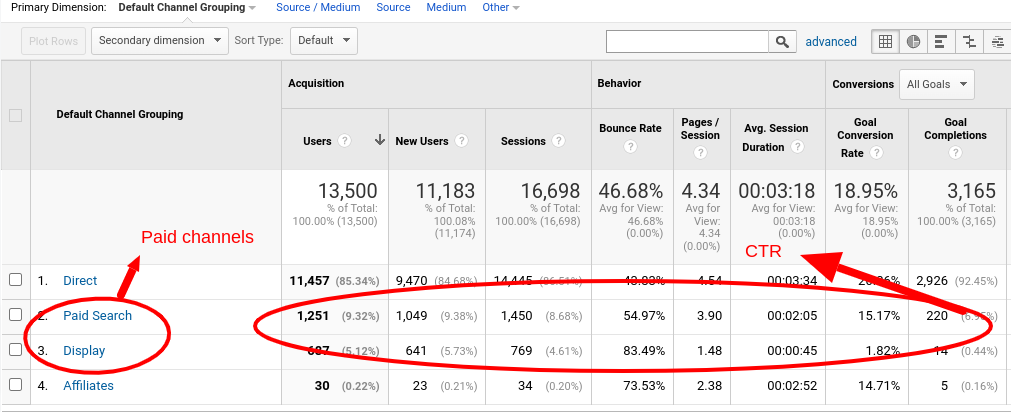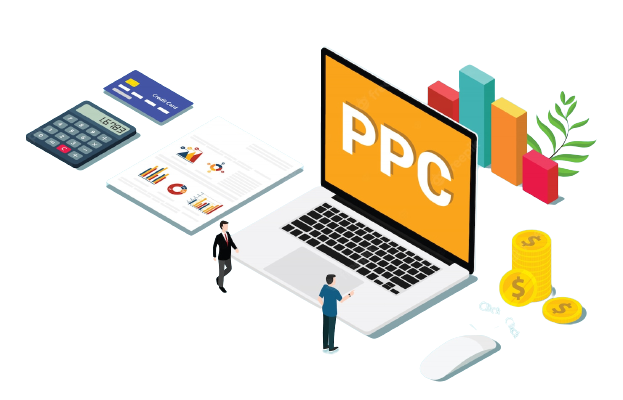PPC Advertising: How to Make It Work for Your Business - In-depth Analysis
Table of contents
Why PPC advertising could be right for your business
PPC advertising best practices?
The key elements of a successful PPC campaign
How to measure the success of your PPC campaign
Conclusion: How to Make PPC Work for Your Business
Introduction
Pay-per-click (PPC) advertising is one of the most effective ways for businesses to reach their target audience and drive conversions. However, many businesses find it difficult to make pay per click marketing work for them.
In this blog post, we'll go over what PPC advertising is, its types, and the key elements of a successful PPC campaign and provide tips on how to make paid search advertising work for your business.
So let's dive in.
What is PPC advertising?

PPC advertising is a form of online marketing that allows businesses to place ads on search engines and other websites. This type of advertising is also known as cost-per-click (CPC) advertising.
The ads are usually displayed at the top or bottom of the search results page and are usually labeled "sponsored" or "ads." With PPC, companies can target specific keywords and demographics to reach potential customers very effectively.
Types of paid advertising
Paid advertising, also known as pay-per-click (PPC) advertising, is a popular digital marketing strategy. There are different types of digital advertising.
Here are some of them and how they can be used to achieve various marketing goals.
-
Search Engine Advertising
This is one of the most popular types of internet advertising where ads show up on search engine results pages (SERPs) when users search for specific keywords. This approach is extremely effective at reaching a specific target audience, generating leads, and driving relevant traffic to a website.
-
Display advertising
This is a form of online advertising that involves placing ads on websites, social media channels, and other online platforms. These ads can be in the form of banners, videos, or other creative formats. Display advertising is a very effective way to reach a wide audience and increase brand awareness.
Maximize Your Online Presence with Our Digital Marketing Agency
-
SEO: Unlock more SEO traffic and see real results with our expert optimization services.
-
Content marketing: Attract and retain customers with high-quality, engaging content that drives traffic and generates leads.
-
Social media marketing: Our team creates epic content that will get shared, get links, and attract traffic on social media platforms.
-
Google Ads: Effective paid strategies with clear ROI. Let our team help you get the most out of your ad spend.
-
Email marketing: Connect with your audience and drive conversions with targeted email campaigns.
-
Web design and development: A visually appealing and user-friendly website is key to attracting and retaining visitors. Our team can help you create a website that converts.
-
Social media advertising
This is a form of online marketing where ads are placed on social media networks such as Facebook, Instagram, Linkedin, or Twitter. These ads can be in the form of sponsored posts, sponsored stories, or other types of promoted content.
Social advertising is a very efficient way to reach a specific audience and increase engagement with a brand.
- Remarketing advertising
With remarketing advertising, companies serve ads to people who have previously visited their website or mobile app. This type of advertising is an excellent way to reconnect with potential customers who have shown interest in your business.
-
Video advertising
This is a type of advertising that uses video channels like YouTube and Vimeo. It is a very effective way to reach a specific audience and increase brand awareness through video content. These ads can be in the form of pre-roll, mid-roll, or post-roll ads.
It is a powerful method for businesses to showcase their products and services in a visually appealing way and increase conversion rates. Video advertising is an effective way to connect with potential customers and leave a lasting impression on them.
-
Shopping advertising
E-commerce PPC advertising is a type of pay-per-click advertising where businesses place ads on online shopping platforms such as Amazon, Google Shopping, and others. This type of advertising is particularly useful for businesses looking to drive traffic to their e-commerce websites and generate sales.
The ads are triggered by specific keywords and are typically displayed at the top of the search results page, making them highly visible to potential customers. This way, businesses can reach a targeted audience and increase their online sales.
Related Resources
The 10 Best Google Ads Agencies In Nairobi
Google Ads Vs Smart Campaigns Which One Is Right For Your Business?
Why PPC advertising could be right for your business
Utilizing PPC advertising, which requires payment per click, is a common strategy employed by businesses to draw in new customers and boost their online visibility. If you are contemplating search engine marketing for your enterprise, here are several reasons why it could be a smart choice for you.
-
Targeted advertising
It allows you to target specific groups of people based on demographics, interests, and behavior. This means you can reach people who are most likely to be interested in your products or services. Instead, you can waste advertising dollars on a broad audience that may not be interested.
-
Quick results
Can be set up and running in minutes, and you can start seeing results almost immediately. This is in contrast to traditional advertising methods such as print or TV ads, which can take weeks or even months to plan and execute.
-
Cost-effective
It can be very cost-effective, especially when compared to traditional advertising methods. You only pay when someone clicks on your ad. So, you do not have to worry about paying for advertisement slots that do not lead to any conversions. Also, you can set a budget for your campaign so that you never spend more than you can afford.
-
Measurable results
This type of advertisement allows you to track and measure the results of your campaign in real time. You can see how many people are clicking on your ad, where they are coming from, and what actions they are taking on your website. This enables you to make real-time adjustments to your campaign to optimize it for maximum results.

- Brand visibility
PPC advertising can help increase your brand's visibility online. When people see your advertisements several times, they recognize and remember your brand. This can lead to increased brand awareness, which ultimately leads to more conversions and sales.
-
Increased website traffic
It can drive a significant amount of targeted traffic to your website, which can lead to more conversions and sales.
-
Flexibility
Paid search campaigns can be easily customized and optimized to achieve maximum results.
-
Multichannel support
PPC ads can be served on multiple platforms like Google, Bing, Facebook, Instagram, etc.
-
Local targeting
Allow you to target specific locations, which is especially useful for businesses with a physical location.
-
Competitive advantage
Give your business a competitive edge by making your products or services more visible online.
What are some best practices for PPC advertising?
Pay-per-click (PPC) marketing is an extremely effective way to drive targeted traffic to your website and generate leads and sales. However, it can also be a costly endeavor if not executed correctly. To ensure the highest return on investment (ROI) for your online advertising campaigns, it's wise to follow some best practices.
-
Clearly define your target audience
Before you launch a PPC campaign, it's imperative to get a clear picture of your target audience. This will help you create ads that appeal to that audience and attract the right people to your website. Make sure you segment your audience by demographics, location, and interests to create the most effective ads.
-
Optimize your landing pages
Once you have identified your target audience and keywords, it is time to optimize your landing pages to ensure they convert visitors into leads and sales. Make sure you have powerful headlines, clear calls to action, and high-quality images and videos.
-
Conduct keyword research

Keyword research is the foundation of any paid search campaign. By identifying the keywords and phrases your target audience is searching for, you can create ads that are more likely to be seen by the right people.
Use various tools like Google Ads Keyword Planner Moz or Spyfu to find the most relevant keywords for your business.
-
Create compelling ad copy
Your ad copy is what entices people to click on your ads. Use compelling language and highlight the benefits of your product or service.
-
Use long-tail keywords
Long-tail keywords are longer, more specific phrases that are less competitive and more likely to convert into customers.
-
Test and optimize your ads
Paid search marketing is not something you do and then forget about. To get the right results, it's imperative to continually test and optimize your ads. Use A/B testing to experiment with different ad copy, headlines, and calls to action, and then analyze the results to determine which versions work best.
-
Try different ad formats
PPC advertising platforms offer different ad formats, such as text ads, display ads, and video ads. Experiment with different formats to see which ones work best for your campaigns.
-
Monitor and adjust your bid prices
Bid prices are an incredibly critical aspect of any PPC campaign. To ensure your ads are being seen by the right audience, it's essential to monitor your bid prices and adjust them as needed. Use tools like Google AdWords to track your bids and adjust them as needed to get better results.
-
Use retargeting
Retargeting is a powerful tool that allows you to serve ads to people who have already visited your website. This can be especially effective for products or services that require a longer purchase decision.
-
Use ad extensions
Ad extensions are additional information you can add to your PPC ads, such as website links, phone numbers, and reviews. These can help increase the visibility and relevance of your ads, leading to higher CTRs and conversions.
-
Use negative keywords
Negative keywords are words or phrases that you add to your PPC campaign to exclude certain keywords from running your ads. This way you can avoid wasting ad spend on irrelevant traffic and improve your return on investment (ROI).
- Track your results
To ensure superior ROI for your PPC campaigns, it's essential to track your results. Use tools like Google Analytics to monitor your website traffic, conversions, and sales, and then use that data to optimize your campaigns.
Related Resources
An-In-Depth Guide To Search Engine Marketing
The Basics Of Search Engine Marketing (SEM)
The key elements of a successful PPC campaign
A successful PPC (pay-per-click) campaign is built on the foundation of several key elements.
These include:
-
Setting up conversion tracking: This allows you to track and measure the effectiveness of your campaign. By setting up conversion tracking, you can see which keywords, ad groups, and ads are driving the most conversions and adjust your campaign accordingly.
-
Campaign structure: A well-structured campaign is essential for success. This includes organizing your keywords and ad groups into tightly themed groups and using negative keywords to prevent your ads from showing for irrelevant search terms.
-
Relevant and compelling ad copy: The ad copy should be relevant to the keywords you are targeting and should also be compelling enough to encourage people to click on your ad.
-
Landing page optimization: The landing page should be optimized for conversions. This means that it should be relevant to the keywords and ads that the user clicked on, and should have a clear and compelling call to action.
-
Constant monitoring and optimization: A successful PPC campaign requires constant monitoring and optimization. This means regularly checking your campaign's performance and making adjustments as needed to improve its effectiveness.
-
Targeting: The ads should be shown to specific groups of people, based on factors such as location, language, device, and time of day. By targeting your ads to the right audience, you can increase their relevance and effectiveness.
-
Ad Schedule: Determines the right time of day to display ads to reach the target audience and optimize conversions. This can also be used to take advantage of peak times in certain industries, such as advertising a sale on clothing during the vacation season.
-
Budget management: Setting and monitoring the campaign budget to ensure that the campaign is profitable and that goals are met. This can include setting daily or monthly budgets, monitoring spending, and making adjustments as needed to stay within budget.
How to measure the success of your PPC campaign
Measuring the success of your campaign is critical to determining the effectiveness of your promotion strategy and identifying areas for improvement. There are a variety of metrics you can use to evaluate the performance of your campaign.
Here are some key metrics and strategies:
-
Click-Through Rate (CTR)

This is the ratio of users who click on your ad to the total number of users who view it. A high CTR indicates that your ad is attracting a significant number of clicks, and is a clear indication of the relevance and targeting of the ad.
To improve your CTR, you should refine your ad copy and targeting to match the interests of your audience better.
-
Conversion Rate
This is the percentage of users who take a desired action on your website after clicking on your ad. This can include filling out a form, making a purchase, or signing up for a newsletter. A high conversion rate shows that your ad is driving valuable traffic to your website and that your landing page is effectively converting visitors into leads or customers.
To improve your conversion rate, you should test different landing pages or offers to see which ones work best.
-
Return on Investment (ROI)
It is a measure of the profitability of your campaign. It is calculated by dividing the revenue generated by your campaign by the cost of the campaign. A high ROI indicates that your campaign is generating a high return on investment and is a clear indication of the overall success of your campaign.
To improve your ROI, you should test different ad formats and targeting options to see which produces the greatest results.
-
Cost-Per-Conversion
Cost-per-conversion (CPC) is the cost of your ad spend divided by the number of conversions. This metric helps you understand the ROI of your PPC campaign. A low CPC is desirable because it indicates that your ads are leading to conversions at a low cost.
To lower your CPC, you should target a more specific audience or optimize your ad text and landing pages.
-
Return on Advertising Spend (ROAS)
Return on Ad Spend (ROAS) is a measure of the profitability of your PPC campaign. It is calculated by dividing the revenue generated by your PPC campaign by the cost of your ad spend. A high ROAS indicates that your PPC campaign is generating a high return on investment.
To improve your ROAS, you should optimize your ad copy and landing pages, target a more specific audience, and test different ad formats.
-
Bounce Rate
Bounce rate is the percentage of visitors who leave your website after viewing only one page. A high bounce rate may indicate that your ad is not relevant to your target audience or that your landing page is not effective.
To improve your bounce rate, optimize your landing page for usability, target a more specific audience, and test different ad formats.
In addition to these critical metrics, there are several other factors that you can use to evaluate the success of your PPC campaign. These include cost per click (CPC), and cost per acquisition (CPA).
Conclusion: How to Make PPC Work for Your Business
PPC advertising is a powerful tool that businesses of all sizes can use to reach their target audience and increase sales. However, many businesses struggle with making PPC advertising work for them.
By choosing the right keywords, using relevant ad copy, optimizing landing pages, targeting the right demographic groups, and using ad extensions and A/B testing, businesses can make PPC advertising work for them.
In addition, regular monitoring and analysis of campaigns can help you make data-driven decisions that improve ROI. If you want to put PPC advertising to work for your business, contact Tabala Digital Solutions today and let us help you achieve your marketing goals.

Published by: Abala Tom
Date: Jan 16, 2023